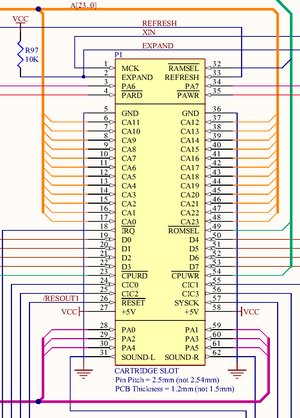We've just updated MediaWiki and its underlying software. If anything doesn't look or work quite right, please mention it to us. --RanAS
Cartridge Slot: Difference between revisions
From SnesLab
(added explanation of game pak connector) |
(note about knobs at bottom of slot) |
||
| Line 1: | Line 1: | ||
The '''Cartridge Slot''' is located on the top of the console, where a [[Game Pak]] is inserted. At the bottom of the cartridge slot is the '''Game Pak (GPK) Connector''', which has 62 pin pads. | The '''Cartridge Slot''' is located on the top of the console, where a [[Game Pak]] is inserted. At the bottom of the cartridge slot is the '''Game Pak (GPK) Connector''', which has 62 pin pads. The knobs of the opposite end of the [[Eject Button]] lever are also at the slot's bottom; they push the Game Pak out of the connector when the button is pressed (at least on the Super Nintendo, not sure about Super Famicom). | ||
The Super Nintendo has small plastic tabs in the cartridge slot to prevent Super Famicom games from being inserted. These can be destroyed to allow Super Famicom games to fit into the cartridge slot and play. | The Super Nintendo has small plastic tabs in the cartridge slot to prevent Super Famicom games from being inserted. These can be destroyed to allow Super Famicom games to fit into the cartridge slot and play. | ||
Revision as of 12:56, 14 May 2023
The Cartridge Slot is located on the top of the console, where a Game Pak is inserted. At the bottom of the cartridge slot is the Game Pak (GPK) Connector, which has 62 pin pads. The knobs of the opposite end of the Eject Button lever are also at the slot's bottom; they push the Game Pak out of the connector when the button is pressed (at least on the Super Nintendo, not sure about Super Famicom).
The Super Nintendo has small plastic tabs in the cartridge slot to prevent Super Famicom games from being inserted. These can be destroyed to allow Super Famicom games to fit into the cartridge slot and play.


